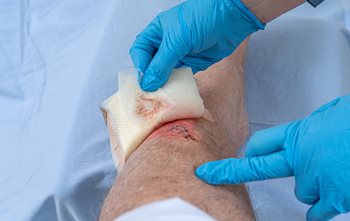
Wound Care in Today's Healthcare Environment
Skin ulceration and wound care is a complex and challenging area of nursing care. And yet, today’s nurses face these skin complications on an almost daily basis in almost every healthcare setting. This instructional course has been designed for nurses providing care to patients with, or at risk for wounds. There are numerous factors that increase one’s risk of a difficult-to-treat wound. With an aging population and an expanding number of individuals with diabetes mellitus, which is associated with wounds of various types, nurses in all settings need a working knowledge of skin integrity issues, including risk factors associated with altered skin integrity, recognition of various types of wounds, preventative measures, and effective interventions. This course has been designed to provide the nurse with a working comprehension of the etiology, treatment modalities, and prevention strategies currently available for the various types of wound encountered in our professional settings.. Numerous pictures and videos are included to enhance the learning experience.
Questions? Check out our FAQs page and How Online IV Certification Works!
Objectives
Upon completion of this course, the participant will be able to:
- Discuss skin anatomy and physiology.
- Distinguish between normal and abnormal wound healing.
- Recognize the major types of wounds.
- Identify the tools used to diagnose and classify wounds.
- List the treatment options used for various types of wounds.
Curriculum
Chapter 1: Normal Skin Anatomy and Physiology
- Epidermis
- Dermis
- Hypodermis
Chapter 2: Normal Wound Healing Process
- Injury Phase
- Inflammatory Phase
- Proliferative Phase
- Remodeling Phase
Chapter 3: Risks for Abnormal Wound Healing
- Risk Factors
- Age
- Nutritional Status
- Co-morbidities
- Chronicity of Skin Insult
- Risk Assessment
Chapter 4: General Wound Treatment Options
- Dressings
- Types
- Debridement
- Types
- Surgical Closure
- First Intention
- Secondary Intention
- Tertiary Intention
- Skin Graft
- Skin Flap
- Skin Substitute
- Nutritional Support
- Hyperbaric Therapy
- Negative Pressure Wound Therapy
Chapter 5: Cuts/Lacerations
- Description
- Treatment
Chapter 6: Perineal Skin Breakdown
- Description
- Treatment
Chapter 7: Skin Tears
- Description
- Treatment
Chapter 8: Decubitus Ulcers
- Description
- Diagnostic Tools
- Treatment
Chapter 9: Diabetic Foot Ulcers
- Description
- Treatment
- Prevention
Chapter 10: Venous Ulcers
- Description
- Diagnostic Tools
- Treatment
Chapter 11: Arterial Ulcers
- Description
- Diagnostic Tools
- Treatment
Chapter 12: Surgical Wounds
- Description
- Treatment
Chapter 13: Burns
- Description
- Treatment
Chapter 14: Bites
- Animal Bites
- Spider Bites
Chapter 15: Legal Implications of Wounds
- Scope of Problem
- Assessment
- Documentation
- California Bill 241
- Implicit Bias in Healthcare
- What is Implicit Bias?
- Implications of Implicit Bias in Healthcare
- How to Reduce Implicit Bias
Price: $96.00
Contact Hours: 8

Course Author

Pamela Clark
Pamela Clark, CRNI, is an infusion nurse with the Houston Methodist Sugar Land Hospital. She has more than 35 years of experience in infusion therapy and infusion education with both licensed nurses and patients. Her experience spans multiple infusion settings including: acute care, long-term care, home infusion, and ambulatory infusion care. She also has experience in oncology and oncology research.
Read Full BioCourse Accreditation
See our Accreditation Statements page to view our accreditation information.